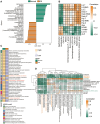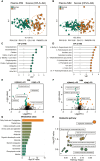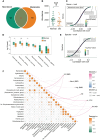Characteristics of the gut microbiota and serum metabolites in postmenopausal women with reduced bone mineral density
- PMID: 38912210
- PMCID: PMC11190063
- DOI: 10.3389/fcimb.2024.1367325
Characteristics of the gut microbiota and serum metabolites in postmenopausal women with reduced bone mineral density
Abstract
Introduction: Emerging evidence suggests that the gut microbiota is closely associated with bone homeostasis. However, little is known about the relationships among the bone mineral density (BMD) index, bone turnover markers, and the gut microbiota and its metabolites in postmenopausal women.
Methods: In this study, to understand gut microbiota signatures and serum metabolite changes in postmenopausal women with reduced BMD, postmenopausal individuals with normal or reduced BMD were recruited and divided into normal and OS groups. Feces and serum samples were collected for 16S rRNA gene sequencing, liquid chromatography coupled with mass spectrometry (LC-MS)-based metabolomics and integrated analysis.
Results: The results demonstrated that bacterial richness and diversity were greater in the OS group than in the normal group. Additionally, distinguishing bacteria were found among the two groups and were closely associated with the BMD index and bone turnover markers. Metabolomic analysis revealed that the expression of serum metabolites, such as etiocholanolone, testosterone sulfate, and indole-3-pyruvic acid, and the corresponding signaling pathways, especially those involved in tryptophan metabolism, fatty acid degradation and steroid hormone biosynthesis, also changed significantly. Correlation analysis revealed positive associations between normal group-enriched Bacteroides abundance and normal group-enriched etiocholanolone and testosterone sulfate abundances; in particular, Bacteroides correlated positively with BMD. Importantly, the tryptophan-indole metabolism pathway was uniquely metabolized by the gut bacteria-derived tnaA gene, the predicted abundance of which was significantly greater in the normal group than in the control group, and the abundance of Bacteroides was strongly correlated with the tnaA gene.
Discussion: Our results indicated a clear difference in the gut microbiota and serum metabolites of postmenopausal women. Specifically altered bacteria and derived metabolites were closely associated with the BMD index and bone turnover markers, indicating the potential of the gut microbiota and serum metabolites as modifiable factors and therapeutic targets for preventing osteoporosis.
Keywords: gut microbiota; osteoporosis; postmenopausal women; serum metabolites; tryptophan-indole metabolism.
Copyright © 2024 Yan, Wang, Yu, Qi, Li, Nan, Wang, Luo, Hua and Wang.
Conflict of interest statement
The authors declare that the research was conducted in the absence of any commercial or financial relationships that could be construed as a potential conflict of interest.
Figures







Similar articles
-
Gut microbiota changes in postmenopausal women with low bone density linked to serum amino acid metabolism.Front Cell Infect Microbiol. 2025 Jul 9;15:1627519. doi: 10.3389/fcimb.2025.1627519. eCollection 2025. Front Cell Infect Microbiol. 2025. PMID: 40703670 Free PMC article.
-
Gut microbiota and metabolite alterations associated with reduced bone mineral density or bone metabolic indexes in postmenopausal osteoporosis.Aging (Albany NY). 2020 May 11;12(9):8583-8604. doi: 10.18632/aging.103168. Epub 2020 May 11. Aging (Albany NY). 2020. PMID: 32392181 Free PMC article.
-
Characteristics of the vaginal microbiota and vaginal metabolites in women with cervical dysplasia.Front Cell Infect Microbiol. 2024 Oct 10;14:1457216. doi: 10.3389/fcimb.2024.1457216. eCollection 2024. Front Cell Infect Microbiol. 2024. PMID: 39450338 Free PMC article.
-
The differences in intestinal flora and metabolites between H-type hypertension and non-H-type hypertension.J Transl Med. 2025 Mar 14;23(1):329. doi: 10.1186/s12967-025-06295-8. J Transl Med. 2025. PMID: 40087692 Free PMC article. Review.
-
Associations Among Estrogens, the Gut Microbiome and Osteoporosis.Curr Osteoporos Rep. 2024 Nov 25;23(1):2. doi: 10.1007/s11914-024-00896-w. Curr Osteoporos Rep. 2024. PMID: 39585466 Free PMC article. Review.
Cited by
-
Progress of research on the gut microbiome and its metabolite short-chain fatty acids in postmenopausal osteoporosis: a literature review.Front Med. 2025 Jun;19(3):474-492. doi: 10.1007/s11684-025-1129-3. Epub 2025 May 10. Front Med. 2025. PMID: 40347368 Review.
-
Gut microbiota changes in postmenopausal women with low bone density linked to serum amino acid metabolism.Front Cell Infect Microbiol. 2025 Jul 9;15:1627519. doi: 10.3389/fcimb.2025.1627519. eCollection 2025. Front Cell Infect Microbiol. 2025. PMID: 40703670 Free PMC article.
-
[Moxibustion Inhibits Postmenopausal Bone Loss by Regulating the Metabolism of Gut Microbiota-Related Serotonin].Sichuan Da Xue Xue Bao Yi Xue Ban. 2025 Jan 20;56(1):129-136. doi: 10.12182/20250160604. Sichuan Da Xue Xue Bao Yi Xue Ban. 2025. PMID: 40109464 Free PMC article. Chinese.
-
The mediating role of caffeine and biological age in the association between dietary index for gut microbiota and osteoporosis.Front Nutr. 2025 Jun 13;12:1559674. doi: 10.3389/fnut.2025.1559674. eCollection 2025. Front Nutr. 2025. PMID: 40584094 Free PMC article.
-
Specific gut microbiota and serum metabolite changes in patients with osteoarthritis.Front Cell Dev Biol. 2025 Feb 14;13:1543510. doi: 10.3389/fcell.2025.1543510. eCollection 2025. Front Cell Dev Biol. 2025. PMID: 40027098 Free PMC article.
References
-
- Benitez-Paez A., Gomez Del Pugar E. M., Lopez-Almela I., Moya-Perez A., Codoner-Franch P., Sanz Y. (2020). Depletion of blautia species in the microbiota of obese children relates to intestinal inflammation and metabolic phenotype worsening. mSystems 5 (2), e00857-19. doi: 10.1128/mSystems.00857-19 - DOI - PMC - PubMed
MeSH terms
Substances
LinkOut - more resources
Full Text Sources
Medical

